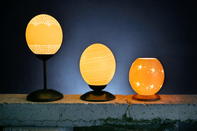Evidence of ostrich shells can be traced back as far as 7000 B.C when they were most probably used as a gift of tribute, drinking vessels or grave goods, symbolizing resurrection and eternal life.

Properties of Ostrich Eggs
Used by early African hunter-gatherers as a light-weight flask with beeswax stoppers to transport their water, ostrich eggshells have found more modern applications - as lights, candle holders and decoration. Similar to the method used by the old tribes, the shell’s contents are first removed by puncturing the shell on the ‘sharp’ end of the egg and shaking the contents out.
An ostrich egg is about 15 cm long and 12 - 13 cm wide, with a volume of about 1 litre. It can weigh about 1.4 kg with its contents and contain 1 - 1.2 kg of egg protein, equivalent to 24 - 28 chicken eggs. The ostrich eggshell is about 3 mm thick and consists of 96% crystalline calcite or calcium carbonate and 4% organic material, mostly proteins. The hardness of the shell is 3 on the Mohs Scale, the scale of mineral hardness. Fingernails have a hardness of 2.5 and glass is between 5.5 and 6.5 on the Mohs scale.
Ostrich Eggshells
Ostrich shells are an undesired byproduct of the ostrich farming industry; ostrich chicks are very valuable and any unhatched or broken egg is considered a loss. Various factors can lead to incubator deaths or unhatched eggs; infertile eggs, poor handling as well as incorrect storage and incubator settings for temperature, relative humidity and air flow.
Even with the best management practices, ostrich eggshells are still a by-product of ostrich farming but fortunately, unhatched or cracked eggs can be further utilised for a variety of decorative and value-added purposes. Even the shards of healthy hatched eggs are used. After cleaning out the contents of the shell and removing the membrane, the eggs are soaked, scrubbed, disinfected and further processed.
Ostrich Shell Products
If the ostrich eggshell is unbroken, it can be used in its natural state or painted, engraved, embossed or varnished. These ostrich eggshell products are used as decoration, lights, candle holders and also in European floristry markets.
Broken ostrich shells are cut and filed into specific shapes and sizes and sold as ostrich buttons, beads and are used in jewellery. The holes are made with a drill similar to a dentist’s drill. Fractured ostrich shards are also used to create inlay work in furniture, vases and other household items.
Ostrich shells are very high in calcium, but may not be used to manufacture calcium supplements.
By Marinda Louw